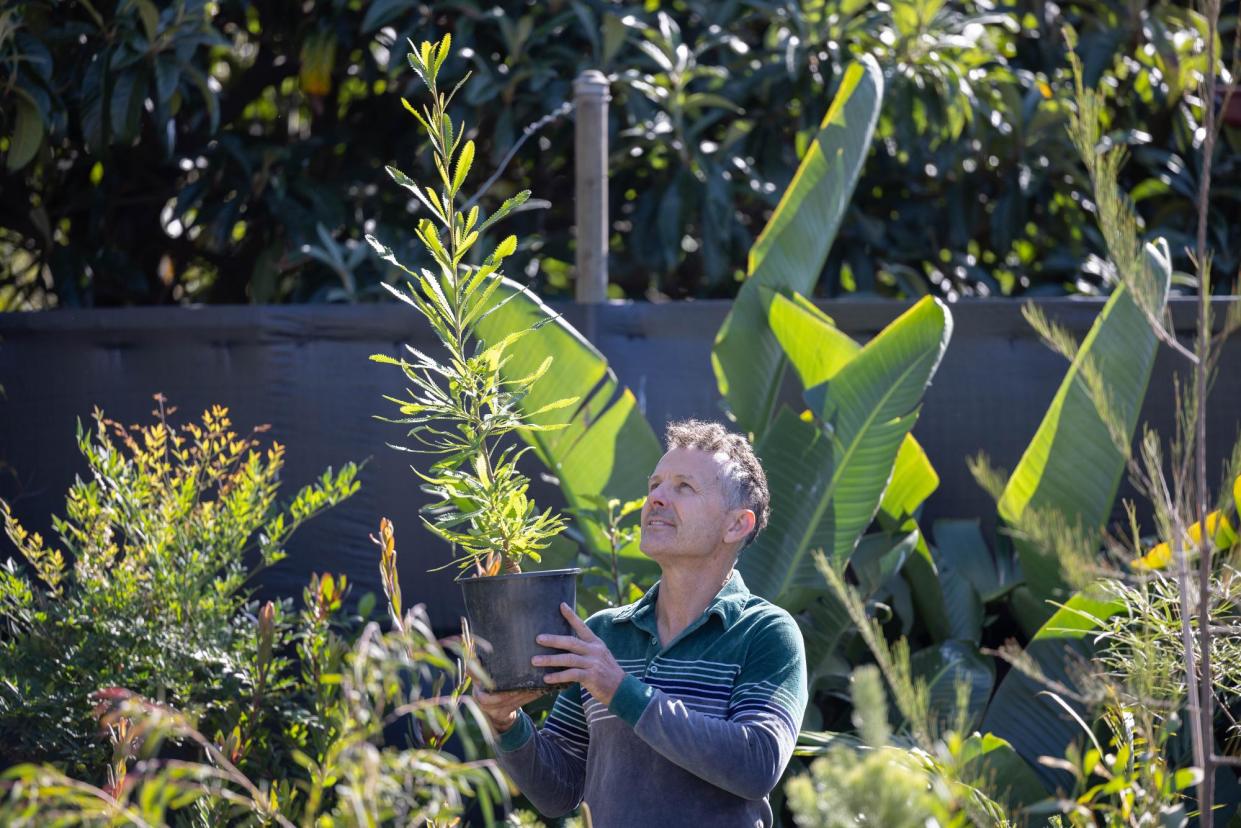‘Planting a tree is hope in action’: the people regenerating urban habitats and growing community

For Stephen Northey, an environmental advocate in Melbourne, tree planting and urban revegetation has allowed him to help restore degraded local ecosystems and foster a much-needed connection with his local area.
The community leader spearheaded a campaign to save Edgars Creek, a tributary that runs through the basalt plains linking Epping, Thomastown and Reservoir to Merri Creek in Melbourne’s northern suburbs.
“Seventeen years ago, the Edgar’s Creek corridor was a wasteland of noxious weeds,” he says.
“Yet hiding there was a beautiful watercourse flowing along a natural rocky course with pockets of remnant vegetation still surviving. I thought the place deserved better so I organised a meeting in the neighbourhood house to garner interest and a community group was formed.”
From an initial meeting, locals undertook thousands of hours of volunteer work using only indigenous plants grown from seeds collected from the catchment. Indigenous bushland and a wetland habitat was successfully reintroduced over the industrial wasteland, preventing the area from being sold to developers after a concerted community campaign.
“Care, vision and inclusion were key success factors, as was access to knowledge about how healthy ecosystems function at a local scale,” he says. Aside from the deep satisfaction of restoring a natural environment, the project transformed the lives of those who participated, says Northey, especially during Covid lockdowns.
“People want to be custodians for their local environment. Friends groups can help facilitate and encourage that desire; that need. In fact, more than ever we need opportunities to connect with our planet and each other,” he says.
Related: Can’t afford a home battery for your solar? It might be worth joining a Virtual Power Plant
How to get involved in tree planting in your area
Tree-planting initiatives are taking place all over Australia, but one of the largest is Plant Trees Australia, organised through Carbon Positive Australia, which provides a platform for volunteers to connect with community groups and offers resources on upcoming tree-planting projects.
“Tree planting is essential to combat climate change and restore healthy ecosystems, so why would you not want to get on board,” says Lauren Purcell, the communications and partnerships coordinator for Carbon Positive Australia.
Her organisation surveys existing bushland to identify naturally occurring plant species to replant in selected areas of remnant bushlands. “Our projects often include more than 50 native species and include shrubs, ground cover and other understory species that help support the natural ecosystem,” she says.
Given Australia currently ranks fourth worst in the world for land clearing and has among the worst species extinction rates globally, these projects provide a counterpoint to the mass land clearing taking place across Australia, she says.
Anyone who has spent time with a tree old enough to be their great-great-grandmother will know its value beyond carbon
Claire Dunn
“Rehabilitating cleared and degraded land can be challenging, particularly as the climate continues to change,” says Purcell.
“It’s crucial that these projects use local seed collections to promote local species, connect remaining bush and forests, and monitor and maintain the new growth, especially during the initial stages.”
What to plant at home in urban Australian settings
While community-based regeneration projects are vital for restoring degraded habitats, for an increasing number of people the desire to get our hands dirty and improve our local environment starts in our own back yard.
Patrick Belford, urban horticulturist and director of Inner City Nature in Melbourne, says a good place to start at home is by replacing grass lawns and nature strips with living ecosystems that will make gardens more biodiverse, encourage insects and native birds, and reduce the need for polluting and noisy lawn mowing.
“Small trees on the north and northern western aspects of a dwelling can create immediate microclimate changes. Deciduous trees and climbing plants on structures play a part in passively cooling and protecting a dwelling in summer and letting the sun warm it in winter,” he says.
Native trees will also support local birdlife and are able to adapt to harsh weather conditions, he says, recommending trees such as coral gum (Eucalyptus torquata), fuchsia gum (Eucalyptus forrestiana) or willow myrtle (Agonis flexuosa) for local Australian gardens.
“Replacing lawns with garden beds and plantings will reduce the need for mowing, and create habitat for pollinating insects that feed the entire food system,” says Belford.
What is ‘rewilding’ and how does it help?
The urge towards nature immersion, tree planting and urban regeneration is not new, but as the climate crisis worsens it has taken on a new relevance and urgency.
Related: Greener washing: how to reduce the carbon and climate impact of your laundry
According to Claire Dunn, author of the book Rewilding the Urban Soul, the human rewilding movement seeks to actively counter the ill effects of urban over-domestication and alienation from nature by returning a quality of wildness and earth-centredness to the way we live and how we understand our place on the the planet.
“In these times of despair and uncertainty, planting a tree is hope in action, the kind of hope that comes not from wishful thinking but by taking actions, maybe small, in support of change,” she says.
“Anyone who has spent time with a tree old enough to be their great-great-grandmother will know its value beyond carbon. They’re elders, and remind us of forest time, that is much much longer than the election cycles. We need to drink from these deeper wells in times like these.”


